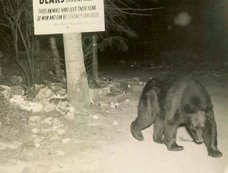There will be many more analyses, investigative hours, and possible charges over the recent report that NFL player turned-soldier Corporal (Army Ranger) Pat Tilman was killed last April by ‘friendly fire’ in Afghanistan. The tragedy of his death stands alongside the collective tragedies of more than 1,400 coalition troops as of this writing.
When you step one hour, one day, one week or one year away from the fact of the individual case what remains is this – he or she is dead, just the same. However, wherever, and whenever the loss, the loss remains as true and real to those who know what loss really is.
Not all deaths are reported and counted in the same way, however. And the “KIA” (killed in action) numbers are the ones we, the public, tend to watch closely. (It makes me wonder if COs are given performance evaluations in which their mortality counts are a measure of their success so they don't want those car accidents, heart-attacks, and drug overdoses to drag their record down.)
Further, we can’t help but marvel at the slug-sticky trail left by those (official investigators?) whose tangled webs were well practiced to confuse or deceive us (to mix metaphors while mangling a quotation along the way) about the truth behind the big 'incidents.'
And that brings us back to Corporal Tilman. Much will be made of this friendly fire incident because of Tilman’s high profile case – he was well known, highly admired, fondly respected and loved by many.
But there are also lesser known cases of friendly fire that we ought to study just as earnestly if we are to learn anything about our commitment to troops and to truth.
Take Marine Corporal Jason David Mileo, for example. Mileo, from Pasadena, Maryland, survived the April 2003 assault on Baghdad but was mistaken for an enemy soldier when he was killed. It took a year for military investigators to lay partial blame on Cpl. Mileo (!) for causing the confusion that led to his own death.
According to the U.S. Central Command, Cpl. Mileo (at the time, unarmed) had removed his flak jacket and helmet and was smoking a cigarette – conduct violations – when he was shot in the back by fellow Marine snipers and spotter. Yet, the report, a full year in the making, absolved military responsibility by saying:
“Even though no one event or person was the catalyst for Corporal Mileo’s death, one break in the chain of events may have spared his life.”
Hmmm. . .I'd like to know who wrote that line; it's sort of Zen-like, kind of out of touch with the Reality that most of us know and live with.
Counting ‘friendly fire’ deaths is perhaps the hardest count of all because of the admission of guilt and the implicit responsibility (public outrage, loss of support for the war, lawsuits, to name a few) that accompanies it. But it’s hard to tell the survivors of those who died from accidents, ‘noncombat weapon discharge,’ disease, or even suicide that their loved ones’ deaths were not brought on at least in substantial part by their service to their country.
It’s time that the algorithm change. Since the U.S. Civil War, at least, military deaths have been tracked by disease, accident, suicide, death-in-combat, murder, among other categories.
But just as we don’t send out brightly dressed fifers and drummers in advance of marching troops anymore because it doesn’t fit modern warfare techniques, we need to stop segregating deaths-in-service by cause.
The aggregate death count – the total count of souls lost -- is good enough for me because they all matter, even those whose futile destinies lay in their own hands by their acts.
After we’ve seen the movie based on the death of Cpl. Tilman, try to remember the movies that you won’t see – of young fellows like Cpl. Mileo whose father's thoughts should linger with us all:
“His death was noble because he was a soldier who willingly went into battle to fight for freedom and liberty and he fell. And he lost his life.”
What else is there to say? The count with Tilman and Mileo?
Two more were “killed in service” of their country.
Period.
skip to main |
skip to sidebar
"Save me from the lion's mouth: for thou hast heard me from the Horns of the Unicorns." (Psalm 22:21) Commentary, complaints, woes, and wonders about Life, the human condition, grubberment, 'popped' culture, and the Planet Girth.



